In this tutorial, we will continue exploring the fascinating world of Excel Conditional Formatting. If you do not feel very comfortable in this area, you may want to look through the previous article first to revive the basics - How to use conditional formatting in Excel.
Today are going to dwell on how to use Excel formulas to format individual cells and entire rows based on the values you specify or based on another cell's value. This is often considered advanced aerobatics of Excel conditional formatting and once mastered, it will help you push the formats in your spreadsheets far beyond their common uses.
Excel conditional formatting based on another cell value
Excel's predefined conditional formatting, such as Data Bars, Color Scales and Icon Sets, are mainly purposed to format cells based on their own values. If you want to apply conditional formatting based on another cell or format an entire row based on a single cell's value, then you will need to use formulas.
So, let's see how you can make a rule using a formula and after discuss formula examples for specific tasks.
How to create a conditional formatting rule based on formula
To set up a conditional formatting rule based on a formula in any version of Excel 2010 through Excel 365, carry out these steps:
- Select the cells you want to format. You can select one column, several columns or the entire table if you want to apply your conditional format to rows.
Tip. If you plan to add more data in the future and you want the conditional formatting rule to get applied to new entries automatically, you can either:
- Convert a range of cells to a table (Insert tab > Table). In this case, the conditional formatting will be automatically applied to all new rows.
- Select some empty rows below your data, say 100 blank rows.
- On the Home tab, in the Styles group, click Conditional formatting > New Rule…
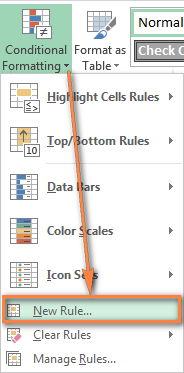
- In the New Formatting Rule window, select Use a formula to determine which cells to format.
- Enter the formula in the corresponding box.
- Click the Format… button to choose your custom format.

- Switch between the Font, Border and Fill tabs and play with different options such as font style, pattern color and fill effects to set up the format that works best for you. If the standard palette does not suffice, click More colors… and choose any RGB or HSL color to your liking. When done, click the OK button.
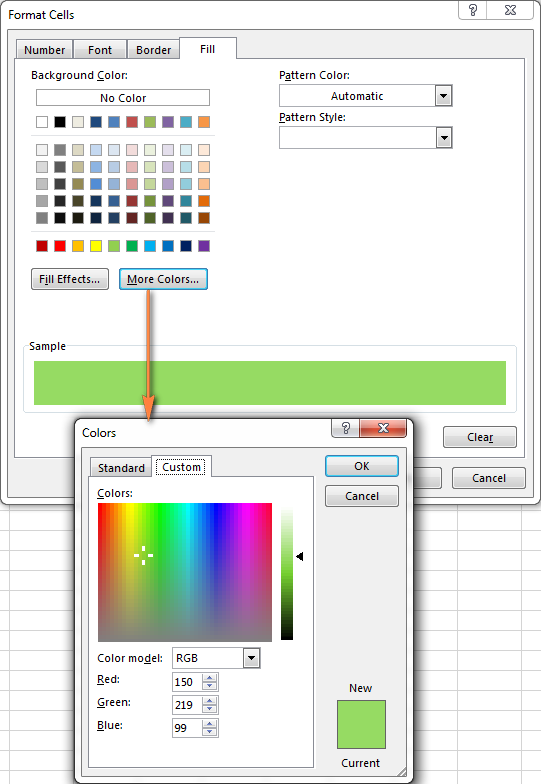
- Make sure the Preview section displays the format you want and if it does, click the OK button to save the rule. If you are not quite happy with the format preview, click the Format… button again and make the edits.
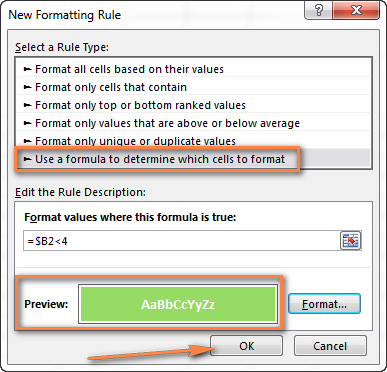
Tip. Whenever you need to edit a conditional formatting formula, press F2 and then move to the needed place within the formula using the arrow keys. If you try arrowing without pressing F2, a range will be inserted into the formula rather than just moving the insertion pointer. To add a certain cell reference to the formula, press F2 a second time and then click that cell.
Excel conditional formatting formula examples
Now that you know how to create and apply Excel conditional formatting based on another cell, let's move on and see how to use various Excel formulas in practice.
Tip. For your Excel conditional formatting formula to work correctly, please always follow these simple rules.
Formulas to compare values (numbers and text)
As you know Microsoft Excel provides a handful of ready-to-use rules to format cells with values greater than, less than or equal to the value you specify (Conditional Formatting >Highlight Cells Rules). However, these rules do not work if you want to conditionally format certain columns or entire rows based on a cell's value in another column. In this case, you use analogous formulas:
| Condition | Formula example |
|---|---|
| Equal to | =$B2=10 |
| Not equal to | =$B2<>10 |
| Greater than | =$B2>10 |
| Greater than or equal to | =$B2>=10 |
| Less than | =$B2<10 |
| Less than or equal to | =$B2<=10 |
| Between | =AND($B2>5, $B2<10) |
The screenshot below shows an example of the Greater than formula that highlights product names in column A if the number of items in stock (column C) is greater than 0. Please pay attention that the formula applies to column A only ($A$2:$A$8). But if you select the whole table (in our case, $A$2:$E$8), this will highlight entire rows based on the value in column C.
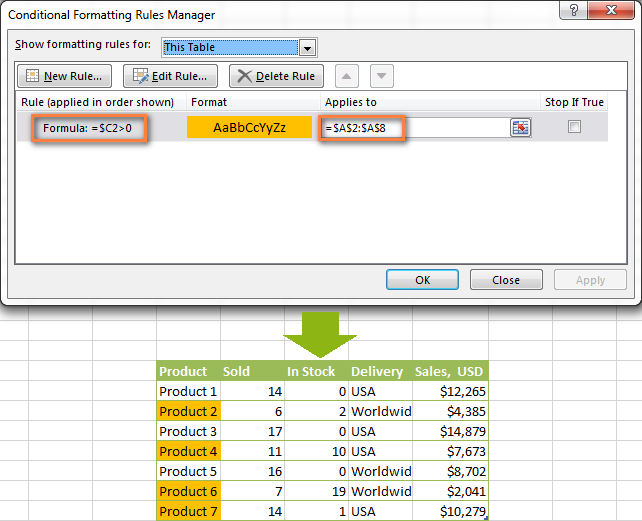
In a similar fashion, you can create a conditional formatting rule to compare values of two cells. For example:
=$A2<$B2 - format cells or rows if a value in column A is less than the corresponding value in column B.
=$A2=$B2 - format cells or rows if values in columns A and B are the same.
=$A2<>$B2 - format cells or rows if a value in column A is not the same as in column B.
As you can see in the screenshot below, these formulas work for text values as well as for numbers.

AND and OR formulas
If you want to format your Excel table based on 2 or more conditions, then use either =AND or =OR function:
| Condition | Formula | Description |
|---|---|---|
| If both conditions are met | =AND($B2<$C2, $C2<$D2) |
Formats cells if the value in column B is less than in column C, and if the value in column C is less than in column D. |
| If one of the conditions is met | =OR($B2<$C2, $C2<$D2) |
Formats cells if the value in column B is less than in column C, or if the value in column C is less than in column D. |
In the screenshot below, we use the formula =AND($C2>0, $D2="Worldwide") to change the background color of rows if the number of items in stock (Column C) is greater than 0 and if the product ships worldwide (Column D). Please pay attention that the formula works with text values as well as with numbers.
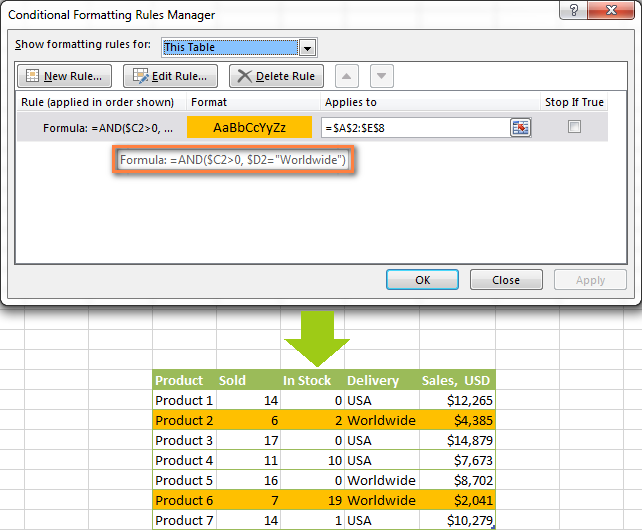
Naturally, you can use two, three or more conditions in your AND and OR formulas. To see how this works in practice, watch Video: Conditional formatting based on another cell.
These are the basic conditional formatting formulas you use in Excel. Now let's consider a bit more complex but far more interesting examples.
Conditional formatting for empty and non-empty cells
I think everyone knows how to format empty and not empty cells in Excel - you simply create a new rule of the "Format only cells that contain" type and choose either Blanks or No Blanks.
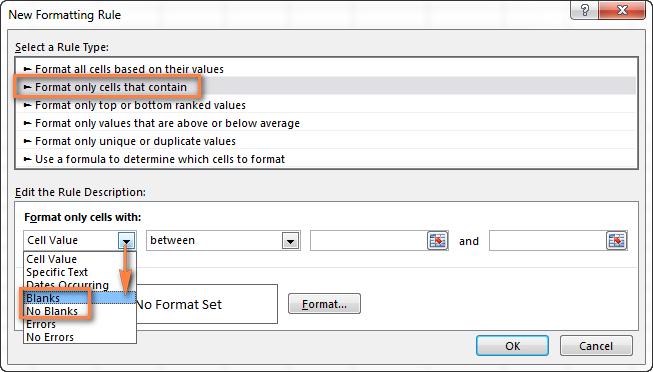
But what if you want to format cells in a certain column if a corresponding cell in another column is empty or not empty? In this case, you will need to utilize Excel formulas again:
Formula for blanks: =$B2="" - format selected cells / rows if a corresponding cell in Column B is blank.
Formula for non-blanks: =$B2<>"" - format selected cells / rows if a corresponding cell in Column B is not blank.
Note. The formulas above will work for cells that are "visually" empty or not empty. If you use some Excel function that returns an empty string, e.g. =if(false,"OK", ""), and you don't want such cells to be treated as blanks, use the following formulas instead =isblank(A1)=true or =isblank(A1)=false to format blank and non-blank cells, respectively.
And here is an example of how you can use the above formulas in practice. Suppose, you have a column (B) which is "Date of Sale" and another column (C) "Delivery". These 2 columns have a value only if a sale has been made and the item delivered. So, you want the entire row to turn orange when you've made a sale; and when an item is delivered, a corresponding row should turn green. To achieve this, you need to create 2 conditional formatting rules with the following formulas:
- Orange rows (a cell in column B is not empty):
=$B2<>"" - Green rows (cells in column B and column C are not empty):
=AND($B2<>"", $C2<>"")
One more thing for you to do is to move the second rule to the top and select the Stop if true check box next to this rule:
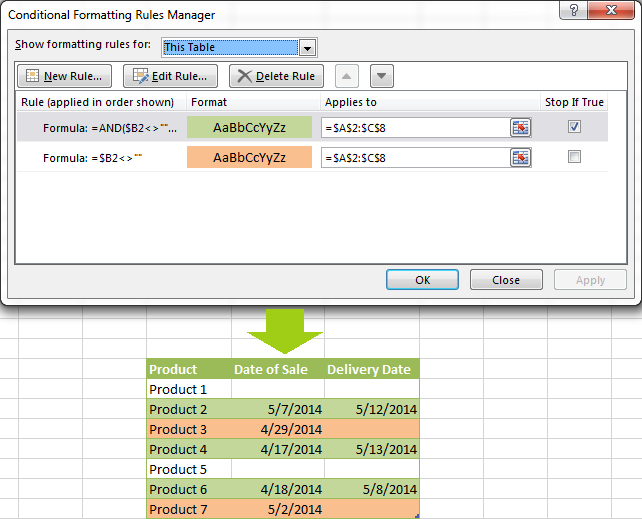
In this particular case, the "Stop if true" option is actually superfluous, and the rule will work with or without it. You may want to check this box just as an extra precaution, in case you add a few other rules in the future that may conflict with any of the existing ones.
For more information, please see Excel conditional formatting for blank cells.
Excel formulas to work with text values
If you want to format a certain column(s) when another cell in the same row contains a certain word, you can use a formula discussed in one of the previous examples (like =$D2="Worldwide"). However, this will only work for exact match.
For partial match, you will need to use either SEARCH (case insensitive) or FIND (case sensitive).
For example, to format selected cells or rows if a corresponding cell in column D contains the word "Worldwide", use the below formula. This formula will find all such cells, regardless of where the specified text is located in a cell, including "Ships Worldwide", "Worldwide, except for…", etc:
=SEARCH("Worldwide", $D2)>0
If you'd like to shade selected cells or rows if the cell's content starts with the search text, use this one:
=SEARCH("Worldwide", $D2)>1

Excel formulas to highlight duplicates
If your task is to conditionally format cells with duplicate values, you can go with the pre-defined rule available under Conditional formatting > Highlight Cells Rules > Duplicate Values… The following article provides a detailed guidance on how to use this feature: How to automatically highlight duplicates in Excel.
However, in some cases the data looks better if you color selected columns or entire rows when a duplicate values occurs in another column. In this case, you will need to employ an Excel conditional formatting formula again, and this time we will be using the COUNTIF formula. As you know, this Excel function counts the number of cells within a specified range that meet a single criterion.
Highlight duplicates including 1st occurrences
=COUNTIF($A$2:$A$10,$A2)>1 - this formula finds duplicate values in the specified range in Column A (A2:A10 in our case), including first occurrences.
If you choose to apply the rule to the entire table, the whole rows will get formatted, as you see in the screenshot below. I've decided to change a font color in this rule, just for a change : )

Highlight duplicates without 1st occurrences
To ignore the first occurrence and highlight only subsequent duplicate values, use this formula: =COUNTIF($A$2:$A2,$A2)>1

Highlight consecutive duplicates in Excel
If you'd rather highlight only duplicates on consecutive rows, you can do this in the following way. This method works for any data types: numbers, text values and dates.
- Select the column where you want to highlight duplicates, without the column header.
- Create a conditional formatting rule(s) using these simple formulas:
Rule 1 (blue):=$A1=$A2- highlights the 2nd occurrence and all subsequent occurrences, if any.
Rule 2 (green):=$A2=$A3- highlights the 1st occurrence.
In the above formulas, A is the column you want to check for dupes, $A1 is the column header, $A2 is the first cell with data.
Important! For the formulas to work correctly, it is essential that Rule 1, which highlights the 2nd and all subsequent duplicate occurrences, should be the first rule in the list, especially if you are using two different colors.

Highlight duplicate rows
If you want apply the conditional format when duplicate values occur in two or more columns, you will need to add an extra column to your table in which you concatenate the values from the key columns using a simple formula like this one =A2&B2. After that you apply a rule using either variation of the COUNTIF formula for duplicates (with or without 1st occurrences). Naturally, you can hide an additional column after creating the rule.
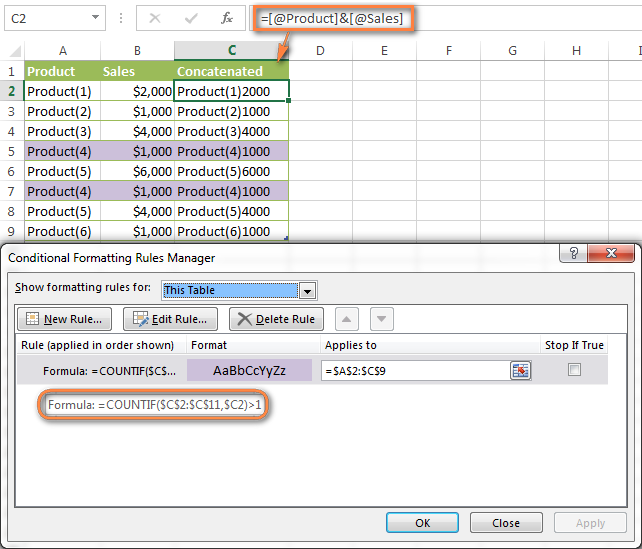
Alternatively, you can use the COUNTIFS function that supports multiple criteria in a single formula. In this case, you won't need a helper column.
In this example, to highlight duplicate rows with 1st occurrences, create a rule with the following formula:
=COUNTIFS($A$2:$A$11, $A2, $B$2:$B$11, $B2)>1
To highlight duplicate rows without 1st occurrences, use this formula:
=COUNTIFS($A$2:$A2, $A2, $B$2:$B2, $B2)>1
Compare 2 columns for duplicates
One of the most frequent tasks in Excel is to check 2 columns for duplicate values - i.e. find and highlight values that exist in both columns. To do this, you will need to create an Excel conditional formatting rule for each column with a combination of =ISERROR() and =MATCH() functions:
For Column A: =ISERROR(MATCH(A1,$B$1:$B$10000,0))=FALSE
For Column B: =ISERROR(MATCH(B1,$A$1:$A$10000,0))=FALSE
Note. For such conditional formulas to work correctly, it's very important that you apply the rules to the entire columns, e.g. =$A:$A and =$B:$B.
You can see an example of practical usage in the following screenshot that highlights duplicates in Columns E and F.
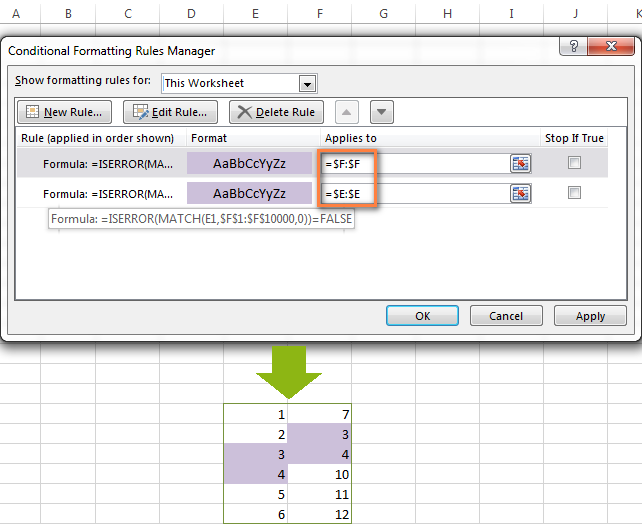
As you can see, Excel conditional formatting formulas cope with dupes pretty well. However, for more complex cases, I would recommend using the Duplicate Remover add-in that is especially designed to find, highlight and remove duplicates in Excel, in one sheet or between two spreadsheets.
Formulas to highlight values above or below average
When you work with several sets of numeric data, the AVERAGE() function may come in handy to format cells whose values are below or above the average in a column.
For example, you can use the formula =$E2<AVERAGE($E$2:$E$8) to conditionally format the rows where the sale numbers are below the average, as shown in the screenshot below. If you are looking for the opposite, i.e. to shade the products performing above the average, replace "<" with ">" in the formula: =$E2>AVERAGE($E$2:$E$8).

How to highlight the nearest value in Excel
If I have a set of numbers, is there a way I can use Excel conditional formatting to highlight the number in that set that is closest to zero? This is what one of our blog readers, Jessica, wanted to know. The question is very clear and straightforward, but the answer is a bit too long for the comments sections, that's why you see a solution here :)
Example 1. Find the nearest value, including exact match
In our example, we'll find and highlight the number that is closest to zero. If the data set contains one or more zeroes, all of them will be highlighted. If there is no 0, then the value closest to it, either positive or negative, will be highlighted.
First off, you need to enter the following formula to any empty cell in your worksheet, you will be able to hide that cell later, if needed. The formula finds the number in a given range that is closest to the number you specify and returns the absolute value of that number (absolute value is the number without its sign):
=MIN(ABS(B2:D13-(0)))
In the above formula, B2:D13 is your range of cells and 0 is the number for which you want to find the closest match. For example, if you are looking for a value closest to 5, the formula will change to: =MIN(ABS(B2:D13-(5)))
Note. This is an array formula, so you need to press Ctrl + Shift + Enter instead of a simple Enter stroke to complete it.
And now, you create a conditional formatting rule with the following formula, where B3 is the top-right cell in your range and $C$2 in the cell with the above array formula:
=OR(B3=0-$C$2,B3=0+$C$2)
Please pay attention to the use of absolute references in the address of the cell containing the array formula ($C$2), because this cell is constant. Also, you need to replace 0 with the number for which you want to highlight the closest match. For example, if we wanted to highlight the value nearest to 5, the formula would change to: =OR(B3=5-$C$2,B3=5+$C$2)

Example 2. Highlight a value closest to the given value, but NOT exact match
In case you do not want to highlight the exact match, you need a different array formula that will find the closest value but ignore the exact match.
For example, the following array formula finds the value closest to 0 in the specified range, but ignores zeroes, if any:
=MIN(ABS(B3:C13-(0))+(10^0*(B3:C13=0)))
Please remember to press Ctrl + Shift + Enter after you finished typing your array formula.
The conditional formatting formula is the same as in the above example:
=OR(B3=0-$C$2,B3=0+$C$2)
However, since our array formula in cell C2 ignores the exact match, the conditional formatting rule ignores zeroes too and highlights the value 0.003 that is the closest match.
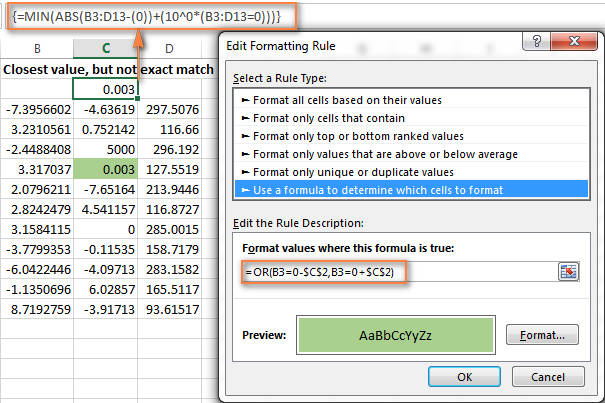
If you want to find the value nearest to some other number in your Excel sheet, just replace "0" with the number you want both in the array and conditional formatting formulas.
I hope the conditional formatting formulas you have learned in this tutorial will help you make sense of whatever project you are working on. If you need more examples, please check out the following articles:
Why isn't my Excel conditional formatting working correctly?
If your conditional formatting rule is not working as expected, though the formula is apparently correct, do not get upset! Most likely it is not because of some weird bug in Excel conditional formatting, rather due to a tiny mistake, not evident at the first sight. Please try out 6 simple troubleshooting steps below and I'm sure you will get your formula to work:
- Use absolute & relative cell addresses correctly. It's very difficult to deduce a general rule that will work in 100 per cent of cases. But most often you would use an absolute column (with $) and relative row (without $) in your cell references, e.g.
=$A1>1.Please keep in mind that the formulas
=A1=1,=$A$1=1and=A$1=1will produce different results. If you are not sure which one is correct in your case, you can try all : ) For more information, please see Relative and absolute cell references in Excel conditional formatting. - Verify the applied range. Check whether your conditional formatting rule applies to the correct range of cells. A rule of thumb is this - select all the cells / rows you want to format but do not include column headers.
- Write the formula for the top-left cell. In conditional formatting rules, cell references are relative to the top-left most cell in the applied range. So, always write your conditional formatting formula for the 1st row with data.
For example, if your data starts in row 2, you put
=A$2=10to highlight cells with values equal to 10 in all the rows. A common mistake is to always use a reference to the first row (e.g.=A$1=10). Please remember, you reference row 1 in the formula only if your table does not have headers and your data really starts in row 1. The most obvious indication of this case is when the rule is working, but formats values not in the rows it should. - Check the rule you created. Double-check the rule in the Conditional Formatting Rules Manager. Sometimes, for no reason at all, Microsoft Excel distorts the rule you have just created. So, if the rule is not working, go to Conditional Formatting > Manage Rules and check both the formula and the range it applies to. If you have copied the formula from the web or some other external source, make sure the straight quotes are used.
- Adjust cell references when copying the rule. If you copy Excel conditional formatting using Format Painter, don't forget to adjust all cell references in the formula.
- Split complex formulas into simple elements. If you use a complex Excel formula that includes several different functions, split it into simple elements and verify each function individually.
And finally, if you've tried all the steps but your conditional formatting rule is still not working correctly, drop me a line in comments and we will try to fathom it out together :)
In my next article we are going to look into the capabilities of Excel conditional formatting for dates. See you next week and thanks for reading!
 by
by
1633 comments
Hi,
I need your help in order to conditional format some cells based on the following example :
If in cell A7 I have the value 03-Aug-2016 (as a date), then the following cells must be filled as this : cell T7 to be green if the cell A7 is 24 hours due , cell U7 to be yellow if the cell A7 is 14 days due and cell V7 to be red if the cell A7 is 30 days due (A7+24 hours = T7 turns green and so on..).
Can you help me please ?
Thank you in advance.
Can someone help me with this, please?
Thank you in advance!
Hi can you possibly help ?
I am struggling - thats an understatement.
I'm looking to highlight maximum and next maximum figure in a col when another col has a figure greater than 4.
(col A had set of figures greater and less than 4 whilst col B has set of figures that maximum 2 need to be highlighted )
thanks - much appreciated
Alex
Hi Svetlana,
I have some data in a spreadsheet across a number of rows and columns that details absence. This is recorded as either A or AA depending on if the absence is authorised or not. I want to be able to conditionally format the totals column at the end of the sheet to highlight a cell when there are 2 consecutive columns in that row with an A or AA in them.
I thought I had it with this: =OR(AND(B8="A*",C8="A*"),AND(C8="A*",D8="A*"),AND(D8="A*",E8="A*"),AND(E8="A*",F8="A*"),AND(F8="A*",G8="A*"),AND(G8="A*",H8="A*"),AND(H8="A*",I8="A*"))
but it doesn't work. I now know that this is because the wildcards don't work in the conditional formatting formula but I don't know how to fix it. Help!
Thanks,
Anna
Hello Mam,
How we sum of these coloumn in z1 (A1, C1, E1, G1,...........x1) in coloumn of Z1
dear mam, your blog is excellent!
i've to create a formula for a condition;
i've a column A in sheet 1 of students name with adjacent column B with students admission no. of year 2015, again i've a column A in sheet 2 with students name admitted in year 2016 with adjacent column with students admission no.i want to highlight the student name entered in sheet 2 if it is admitted in previous year, with his/her admission no. in adjacent column automatically. by conditional formating with formula =countif()>1 i've done it but i cannot entered automatically admission no.
plz give the complete solution. thank you!
Hi Svetlana,
I was wondering if I could use this function to highlight in yellow a range of cells based on a customer number?
Thanks in advance for your help!
Jim
Hi Jim,
Sure, you can. If you explain the task in more detail, I may be able to suggest an appropriate formula.
I am having difficulty conditionally formatting a cell that has to meet several conditions. First the column name (ID number) has to match 1 of 5 other cells and second the formula in the cell has yielded an "X".
I have tried numerous conditional format formulas but have not found the one that works. The formula the subject cell calculates to display either an "X" or " ". I need to highlight the "X" if the column ID number matches one of five other cells.
Hi I am trying to design a sheet, that in say sheet1 has names of customers and in the second column a list of their purchases, so in sheet 2 when their name is typed it will bring up their purchase (if you know what I mean)
Hi, I am trying to design a sheet where in another sheet(sheet 1) there will be a list of all persons names and in another column a list of they purchase, so on a new sheet(sheet 2) when a persons name is entered in a box their purchase is shown beside it
Hello,
I'm trying to auto-highlight a spreadsheet. Column A is the Company Name, B is Invoice #, C is Amount, D is Due Date, and E is Date Paid. I'm using the following rules already:
Highlight Red if past due: =NOW()
Highlight Yellow if due within 7 days: =NOW()+7
Leave blank if no value in Due Date: =ISBLANK(A1)=TRUE
I need to know the formula to highlight the entire row GREEN if a date is entered in Column E.
Thanks!
Jenny
Oh, the formulas that I'm already using are highlight column D only.
Solved it!
I created a new column that "Paid?" and used this formula so when you enter "Yes" in the paid column it highlights the entire row green.
=$E1="YES"
How do I create conditional formatting that calls out if a cell value is less than either the cell above or the cell to the left? Example is below - cell D4 is less than D3 and C4.
A B C D
1 31.60 33.35 36.00 38.55
2 32.75 32.80 37.80 40.55
3 33.90 36.10 39.60 42.45
4 34.60 36.85 40.65 40.35
5 35.55 38.10 42.10 45.05
Dear mam, how to color the new entry data by not showing the data. For example. You will enter "1" in the cell, if you enter one activity but instead of "1" appears, that cell data will be blank colored.
Hello,
I want to relate one cell to Another for example in cell B4 i have two Options Currencies like USD and AED now in the next cell B5 when i enter an amount it should be related with B4 if USD is selected than the format for that cell should be $ and when AED is selected in B4 than automatically B5 format should be for AED. Please help me with giving proper formula
Hello,
I inherited a spreadsheet worth of 10+ years of data, but someone got into it and messed with it, so now the condition not working properly any more. I'm a newbie to conditional formatting, I need help to fix it, please!
It's a big file, contains thousands of row and dozens of column. And here is what I need:
if any cell in column K contain a specific text "WAT", then in that same row, cell B, C, G, and K will be fill with color. How do I format this? thank you in advance!!
Hi ,
Is there any formula for this question below :
cell 1 will have month of feb 2016 entered
cell 2 will have month march 2016 entered
cell 3 will have month dec 2015 entered
is it able to cross check within 3 cells whether the date in each cells is consecutively 3 months based on the dates if not need to appear the cells in red colour .
Need to cover a row with hash marks to blank it out when wrong part number is listed. Problem is the following formula works when X is added in one cell but not the other.
Row A37:F37 is covered by blue hashes if X is in A7 and C12 = TT60000678-
Part number in C12 is entered by formula when X is put in A7
To change part number in C12 requires an X in D22 or E22. Formula for this is in C12 .
=IF(AND(OR(D22="X",E22="X"),A7="X"), "TT60003571-",IF(AND(A7="X",(E4=293,E4=701,E4=601,E4=731),"TT60002639-", ""))))))
Conditional Formatting Formula for adding blue hash marks in A37:F37 works fine when X is put in E22.
It does not work when X is put in D22
I am using excel 2010. Have had this problem in the past with other formulas/configurations. W
Have used similar formulas in earlier versions of Excel and did not have this problem.
Hi, Can you help me with this?
I am preparing a system so staff members can build part numbers based on certain questions which I have embedded into "drop down lists".
My issue is that I have two questions which require a different drop down list to appear based on the answer of the previous question.
Example question 1, please chose C or SS.
Question 2
Please choose size.
If they chose "SS" on question 1, I want to offer a drop down list with values from 2-10 on question 2
If they chose "C" on question 1, I want to offer a different drop down list offering values 11-20
So if Cell C5 = C I want drop down list A
If cell C5 = SS I want drop down list B
Is this possible?
Many thanks,
Kyle
Hello Svetlana, I have a worksheet there are many columns like column A, B,C,D etc. Column A have Product ID, Column B have Product Description C got 1 date of month D got 2 date of month as on and last column got closing stock. i got values from some columns in this worksheet from another worksheet using formula. but the problem is that on a specific date it got values for that dates columns and rest all columns got 0 value. I want when a column got values from formula is got paste special at a specific time (11 am) automatically, so that on next day when the current day's value updated on respective column last days value did not change.
could you help me on this.
Thanks
I am trying to apply conditional formatting based on the value in other cell. Condition is if column J has specific text (from the list) row to be highlighted yellow. If columns K, L, M, N have any text, then row should have not color. I am able to format this based on the numbers in columns K, L, M, N not the text. Please help.
I have two columns, F and H. I put a 1 in F if the application is approved and the H column equals the number of times an application has been submitted by someone. in column H, i want the cell to highlight green when the application is approved on the first attempt (f=1 and h=1). When applying the conditional formatting, I can get it to work if I set it up for a single cell ie =and(h5=1, f5=1) and applies to $h$5 but I want to apply this formatting to the entire H Column. If I change the formulat to =and(h:h=1, F;F=1) and apply it to =$h$h, no cells are highlighted. Can you help me tweak my formula to do this?
Hi i want to know when i want a cell to be yellow when another cell has no data but then if i add data to that cell then the yellow should then go back to no fill.
How do i do that
How to highlight calendar cells
based on start,estimated & actual date in excel
I tried using the below formula but it doesnt work
If =(F$4<$B5), no format (or white fill), Stop If True
If =AND(F$4<=$C5, F$4<=$D5), fill blue
If =AND(F$4$D5), fill green
If =AND(F$4>$C5, F$4<=$D5), fill red
Hi, any help is greatly appreciated:
I am trying to use conditional formatting to apply to individual cells across a row based on each of their values, relative to one value in another (Absolute) cell. Data is corresponding in 2-row sets...
Specific example:
A1=10
B2=12, C2=11, D2=9
A3= 20
B4=21, C4=20, D4=19
I want to create a conditional formatting formula that is something like this:
Format IF: =$A1>B$2.
I want B2, C2, D2, etc. to be evaluated compared to $A$1, and be highlighted individually (not row 2, just the individual cell), and ONLY if A1 is greater than the value in the cell. I want B4,c4,d4... to ref $A3, and so on down the sheet. (Note: it's ok if b3 references a2 in between, because all Even numbered cells in column A = 0; a2=0,a4=0, etc, therefore b3,c3,d3...which are all positive, would not get formatted, which is good.)
In the above example, I would want this result:
D2 and D4 are highlighted/formatted (because they are less than A1 and A3 respectively), and nothing else is formatted.
I am having trouble figuring out the absolute reference. I also don't want to have to apply it individually to each row - maybe I need to create the formula once and drag it down? (Copy conditional formatting?) because I have hundreds of rows similar to what is shown above.
(I'm more familiar with google sheets, and this seems much easier to accomplish in gsheets...)
Thanks again for any help!
Hi there I am trying to use conditional formatting where I want the cell to appear yellow based on a true result. If user selects "Y" from the drop down list in cell A1; B1 is prompted the user to enter name of authority; C1 cell should go yellow to indicate this needs filling. Is C1 that I want to be formatting based on on the result of B1 being true. Can you advise?
Regards
Abs
hi
I have some values in b5:b14 currency format, the same way C5:c14 date format. I need recently increased amount, which is increased and which date.
so please suggest which formula I can use for the scenarios.
Example 1 :
amount date
100 01/01/16
50 02/02/16
100 03/02/16
100 04/01/16
here increased value is 100 with date 03/02/16, this values I need in C4 and c5.
amount date
100 01/01/16
100 02/02/16
100 03/02/16
100 04/01/16
here there is no any changes in amount so it should be 100 with 01/01/16 in C4 and c5.
Hi friends,
Myself Mahesh, currently I am working as a hr. Can anybody tell me the usage of "format cells that rank in the top" and "format cells that rank in the bottom" in conditional formatting in excel 2010.
Regards
Mahesh
I'm working on a spreadsheet for forecasting staffing. There is an "open headcount" row in several portions of the spreadsheet, and I want to create a formula that will highlight only the cells in the "open headcount" rows where a number > zero has been entered. I know I could manually apply that condition to each one of those rows, but I want to be able to apply to the entire spreadsheet at once.
Appreciate any help!
You have already assisted someone with this question, but I'm unable to get the formula offered to work.
Example: When I type "At Home" into cell B4, I need I4 to show "Adnan".
Formula used: AND=($B4="At Home", $I4="Adnan")
Can you help?
I'm attempting to color cells that are dates only. if an alpha based word or statement appears I want it to ignore those. Is there a way to have it look for numbers only? i.e-. 07/12/2016 (shaded), Tom (Not shaded).
But without creating a rule for EVERY word I want excluded from the shading rule?
I guess what I'm looking for is a symbol or code phrase that tells it to look for "all text" or "all number".
i wish to format a row based on the condition that the cell in the row on total probability is less than 20 and the total consequences is less than 23
Hi there.
I have a probably not too tricky question, but I am not so familiar with conditional formatting.
I want to format my dataset (22x12 values) with the 3 color rule, but based on the values of another dataset. So that the color can be used as additional information. Can you help me with that?
Thanks a lot for your help!
I have 5 week calendars and the first week show the previous month dates and the first line have merge 5 cell when I have the days for 7 days start Sunday and the second line I have 10 cell/box where i have different information. I need to do a month calendar and transfer all the week information star the the first on the month.
Do you know How I can automatic transfer the information? (Formula)
Hi,
I have a tab with hundreds of rows, and there is a column with job title and the next column is a salary (tab 1). Those jobs are linked from another tab with salary (tab 2) this is my source tab. I would like that when I change the job title on tab 1, that the salary (next column) also changes (it would get its data from tab 2). Tab 2 is static, but tab 1 is dynamic. Not certain how to write a formula or would I need something else, a macro ? Thanks
Hi ,
Can you help me know how to highlight particular cell using conditional formating or any other method for functions
I just want to highlight particular column cell with reference to previous column cell.
for eg :
A B C
1 3,000 3,500 3,200
2 3,200 3,300 3,400
So here B1>A1.so B1.i.e 3500 should be highlighted.
similarly B2>A1, so B2 should be highlighted.
Similarly C2.
So the formula should be applied to entire sheet
Dear sir,
I list down a simplified data table for reference for my question as follow:
A B C D E
S.no Name Profession Groupings Days of report
1 AAA Specialist 5
I want to highlight Name cell(AAA) by conditional formatting if Profession =Specialist, Day of report >=5.
However, it does not work. May I know what is the problem. Your advice please.
Regards.
Michael
The formula I use: AND($B2="Specialist;$E2>=5)
Hi,
I'm trying to set up conditional formatting that will put a number in a different cell depending on the colour (contents of another cell).
For instance, if % are below 33% then the cell goes red, between 33% and 66% it goes orange, and above 66% it goes green. What I want from this is that it will fill in the next cell with a letter based upon those percentages. Is that possible?
Thanks in advance.
I am trying to format dispatch time against actual time. example: Column $AD$6 has Target Dispatch time of 15:45, column $AE$6 will have actual dispatch time of 22:08. If actual dispatch time is greater than Target Dispatch time, I would like to fill with red.
Hello,
I am sorry if this has been asked earlier, but i could not find it, neither here nor on google. is there a way to compare cells in column A to their respective cells in column B, and color the cell green if the numbers are the same, and red of they are not? SO, if A1 reads 3, and B1 reads 3, i want B1 to color green. and the same for A2 and B2, A3 and B3, and so on. i could just do it cell by cell, but that would take days, and i cannot find a quicker way to do it. even with a macro, doing it cell by cell would take ages i think.... I am using Excel 2013.
Thanks a lot in advance!
Hi RengerD,
Please try to do the following:
1. Select a range in column B. For example B1:B4.
2. Click Conditional Formatting -> New Rule.
3. Select the "Use a formula to determine which cells to format".
4. In the Formula field type "B1=A1".
5. Click the Format button to set the format you need.
6. Click OK.
Excel 2010 conditional formatting.
I cannot copy my conditional formatting down the rows, I need my row reference to change i.e. A1 to A2, A3 etc. but it retains at absolute reference A1 when I copy it down the rows. When I try to remove the dollar sign in edit rule, it automatically adds the dollar sign back. The rule I am using is:
Format only cells that contain.
Cell value not between:
=$A$1 and =$A$2, (Have test reference number here)
When I copy this down, the rows $A$1 and $A$2 remain absolute where I need them to change to reflect the row numbers I have copied to, removing the dollar sign has no effect as it just defaults back to dollar within the rule.
Thanks in anticipation.
Hi Dave F,
I've tried on my Virtual PC with Excel 2010 and everything works as expected.
To be able to assist you better please describe your task in more detail.
Good Afternoon,
Would you be able to assist with this situation ?
I have two columns..
The first column has bill id. The second has line id.
What I need to do is find replicating or non consecutive line id only if the bill id is the same.
For example IF THE left column has the same value, it should start at one and end at the last same number. 5555 should be 1 2 3 and it should start over at 5556 at 1, 2, 3…..
5555 1 TRUE
5555 2 TRUE
5555 2 FALSE
5556 1 TRUE
5556 2 TRUE
5556 3 TRUE
55111 1 TRUE
55111 1 FALSE
55222 2 FALSE
55333 1 TRUE
55333 5 FALSE
THANK YOU FOR YOUR HELP
Hi i am new to Excel sheets and having trouble in creating dependent dropdown list for columns
Hi Neeraj,
Please look at the following article, it should help:
https://www.ablebits.com/office-addins-blog/dependent-cascading-dropdown-lists-excel/
Hi,
I'm trying to use conditional formatting to format cells that go over 6 months and 12 months.
All cells have different dates and it's not based on today's date. It's based on a meeting date?
Hi Catherine,
Please try to do the following:
1. Select a range in column A. For example A1:A10.
2. Click Conditional Formatting -> New Rule.
3. Select the "Use a formula to determine which cells to format".
4. In the Formula field type the following formula:
=OR($A1 > DATE(YEAR($B$1), MONTH($B$1)+6, DAY($B$1+$A$1)), $A1 < DATE(YEAR($B$1), MONTH($B$1)-6, DAY($B$1)))
5. Click the Format button to set the format you need.
6. Click OK.
The date values in A1:A10. The meeting date is in B1.
I want my D column to highlight red under conditional formatting if it is more than 14 days after/later than column c.
Can this be done on conditional formatting? and if so what would the answer be?
Thank you.
Hi Lauren Dicker,
Please try to do the following:
1. Select a range in column D. For example D1:D10.
2. Click Conditional Formatting -> New Rule.
3. Select the "Use a formula to determine which cells to format".
4. In the Formula field type the following formula:
=ABS(DAYS(D1,C1))>14
5. Click the Format button to set the format you need.
6. Click OK.
Is it possible to change a cell to 0 (with a strikethrough) if a cell is less than or equal to 0 using conditional formatting? Thanks in advance for any help!
Hi Brad,
Please try to do the following:
1. Select a range with your data.
2. Click Conditional Formatting -> New Rule.
3. Select the "Format only cells that contain".
4. Select the "less than or equal to" option = 0.
5. Click the Format button.
6. Select the Number tab and Custom format.
7. Fill "-;-" value in the Type field.
8. Click OK. Click OK.
sorry if this has been listed but I cannot find it.
I need to fill a cell with RED and Bold Black text stating "PLEASE SPECIFY DETAILS".
But only if another cell has a particular selection made from a validation list.
So B40 is blank. if B38 = "Other (specify)" (seleceted from a validation drop down list) then B40 turns red with black bold text stating "PLEASE SPECIFY DETAILS".
I really would appreciate any help with this. Conditional formatting is not one of my best areas of knowledge
Thank You
Hi Ben,
Please try to do the following:
1. Enter the following formula for cell B40:
= IF($B$38="Other (specify)", "PLEASE SPECIFY DETAILS", "")
2. Select cell B40.
3. Click Conditional Formatting -> New Rule.
4. Select the "Use a formula to determine which cells to format".
5. In the Formula field type the following formula:
=$B$38="Other (specify)"
6. Click the Format button to set the format you need.
7. Click OK.
I need to figure out a way to say "In the case of 1, use vlookup for Chart A. In the case of 2, use vlookup for Chart B...etc" through at least 4 (and maybe more with different files), all without using the IF function.
This is because the model number affects the code that is used to define the material. So Model 1 may use "15" for "concrete block," but Model 2 may use "15" for "metal," etc.
Thank you!
I would like to format one cell (fill yellow) if another cell contains one of roughly 80 different text values. I've tried formatting cell C2 with =OR($W$2=“I63.00”, $W$2=“I63.011”, $W$2=“I63.012”, $W$2=“I63.01”, $W$2=“I63.02”, $W$2=“I63.031”, $W$2=“I63.032”, $W$2=“I63.039”, $W$2=“I63.09”, $W$2=“I63.10”, $W$2=“I63.111) for example, but it doesn't seem to work. Suggestions?
Thanks!
Hi Damon,
Please check the format for cell $W$2. It should be "Text" if you compare the text values, not "General".
Hi, I have a list of all colleagues in our coy, some have left already, so for those I enter the exit date.
Now what I want is to highlight not only the cell which contains a date value but "the whole row" based on the exit date column.
Could I get some advice please.
Many Thanks
Hi Nel,
To highlight the whole row please add the absolute reference symbol "$" before the cell reference. For example, if you have the dates in column B:
=$B1=DATE(2016,1,1)
Hi, I'm looking to make a formula that highlights the days Friday-Sunday but I'm hitting an issue with my cells. The cells that I want highlighted have a formula in them that takes the date from say C2 and adds 14 days to get the date I need. I'm assuming that's why the weekday formula isn't working for me because there's a formula in the cell and not a date. Any suggestions?
Hi Cynthia,
Do you use the following formula?
=OR(WEEKDAY(A1) = 6, WEEKDAY(A1) = 7)
Hi
I have been trying to do a sum but I am not sure how
I have a 2 rows of numbers
Cell A Cell B Cell C
58.50 56.33€ in cell c What I would like to do is something like this =if cell B is > than Cell A minus Value e.g 0.50
58.50 51.90€
59.70 56.92€
60.30 57.32€
69.00 68.90€
I hope this makes sence
Hi George,
You need a formula like the following:
=IF(B1>A1, value-if-true, value-if-false)